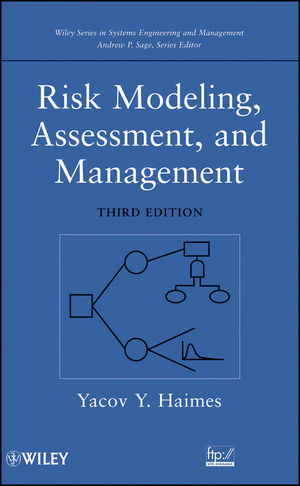Yacov Y. Haimes
ISBN: 978-0-470-28237-3
Hardcover
1010 pages
January 2009

- Examines timely multidisciplinary applications, problems, and case histories in risk modeling, assessment, and management Risk Modeling, Assessment, and Management, Third Edition describes the state of the art of risk analysis, a rapidly growing field with important applications in engineering, science, manufacturing, business, homeland security, management, and public policy. Unlike any other text on the subject, this definitive work applies the art and science of risk analysis to current and emergent engineering and socioeconomic problems. It clearly demonstrates how to quantify risk and construct probabilities for real-world decision-making problems, including a host of institutional, organizational, and political issues. Avoiding higher mathematics whenever possible, this important new edition presents basic concepts as well as advanced material. It incorporates numerous examples and case studies to illustrate the analytical methods under discussion and features restructured and updated chapters, as well as:
Preface. Acknowledgments. PART I: FUNDAMENTALS OF RISK MODELING, ASSESSMENT, AND MANAGEMENT. 1. The Art and Science of Systems and Risk Analysis. 1.1 Introduction. 1.2 Systems Engineering. 1.3 Risk Assessment and Management. 1.4 Concept Road Map: The Farmer's Dilemma. 1.5 Epilogue. References. 2. The Role of Modeling in the Risk Analysis Process. 2.1 Introduction. 2.2 The Risk Assessment and Management Process. 2.3 Information, Intelligence, and Models. 2.4 The Building Blocks of Mathematical Models. 2.5 The Farmer's Dilemma Revisited. 2.6 Example Problems. References. 3. Identifying Risk Through Hierarchical Holographic Modeling. 3.1 Hierarchical Aspects. 3.2 Hierarchical Overlapping Coordination. 3.3 Hierarchical Holographic Modeling (HHM). 3.4 Hierarchical Holographic Modeling and the Theory of Scenario Structuring. 3.5 Adaptive Multiplayer HHM (AMP-HHM) Game. 3.6 Water Resource System. 3.7 Sustainable Development. 3.8 HHM in a System Acquisition Project. 3.9 Software Acquisition. 3.10 Hardening the Water Supply Infrastructure. 3.11 Risk Assessment and Management for Support of Operations Other Than War. 3.12 Automated Highway System. 3.13 Food-Poisoning Scenarios. References. 4. Decision Analysis. 4.1 Introduction. 4.2 Decision Rules Under Uncertainty. 4.3 Decision Trees. 4.4 Decision Matrix. 4.5 The Fractile Method. 4.6 Triangular Distribution. 4.7 Influence Diagrams. 4.8 Population Dynamics Models. 4.9 Phantom System Models. 4.10 Example Problems. References. 5. Multiobjective Trade-Off Analysis. 5.1 Introduction. 5.2 Examples of Multiple Environmental Objectives. 5.3 The Surrogate Worth Trade-off (SWT) Method. 5.4 Characterizing a Proper Noninferior Solution. 5.5 The Surrogate Worth Trade-off Method and the Utility. Function Approach. 5.6 Example Problems. 5.7 Summary. References. 6. Defining Uncertainty and Sensitivity Analysis. 6.1 Introduction. 6.2 Sensitivity, Responsivity, Stability, and Irreversibility. 6.3 Uncertainties Due to Errors in Modeling. 6.4 Characterization of Modeling Errors. 6.5 Uncertainty Taxonomy. 6.6 The Uncertainty Sensitivity Index Method. 6.7 Formulation of the Multiobjective Optimization Problem. 6.8 A Robust Algorithm of the USIM. 6.9 Integration of the USIM with Parameter Optimization at the Design Stage. 6.10 Conclusions. References. 7. Risk Filtering, Ranking, and Management. 7.1 Introduction. 7.2 Past Efforts in Risk Filtering and Ranking. 7.3 Risk Filtering, Ranking, and Management A Methodological Framework. 7.4 Case Study: An Operation Other Than War. 7.5 Summary. References. PART II: ADVANCES IN RISK MODELING, ASSESSMENT, AND MANAGEMENT. 8. Risk of Extreme Events and the Fallacy of Expected Value. 8.1 Introduction. 8.2 Risk of Extreme Events. 8.3 The Fallacy of the Expected Value. 8.4 The Partitioned Multiobjective Risk Method. 8.5 General Formulation of the PMRM. 8.6 Summary of the PMRM. 8.7 Illustrative Example. 8.8 Analysis of Dam Failure and Extreme Floods Through the PMRM. 8.9 Example Problems. 8.10 Summary. References. 9. Multiobjective Decision-Tree Analysis. 9.1 Introduction. 9.2 Methodological Approach. 9.3 Differences Between Single- and Multiple-Objective Decision Trees. 9.4 Summary. 9.5 Example Problems. References. 10. Multiobjective Risk Impact Analysis Method. 10.1 Introduction. 10.2 Impact Analysis. 10.3 The Multiobjective, Multistage Impact Analysis Method: An Overview. 10.4 Combining the PMRM and the MMIAM. 10.5 Relating Multiobjective Decision Trees to the Multiobjective Risk Impact Analysis Method. 10.6 Example Problems. 10.7 Epilogue. References. 11. Statistics of Extremes: Extension of the PMRM. 11.1 A Review of the Partitioned Multiobjective Risk Method. 11.2 Statistics of Extremes. 11.3 Incorporating the Statistics of Extremes into the PMRM. 11.4 Sensitivity Analysis of the Approximation of f4 (·). 11.5 Generalized Quantification of Risk of Extreme Events. 11.6 Summary. 11.7 Example Problems. References. 12. Bayesian Analysis and the Prediction of Chemical Carcinogenicity. 12.1 Background. 12.2 Calculating Sensitivity and Specificity. 12.3 Battery Selection. 12.4 Determining the Performance (Predictivity and Selectivity) of the Test Battery. 12.5 Trade-offs and Policy Analysis. References. 13. Fault Trees. 13.1 Introduction. 13.2 Basic Fault-Tree Analysis. 13.3 Reliability and Fault-Tree Analysis. 13.4 Minimal Cut Sets. 13.5 The Distribution Analyzer and Risk Evaluator Using Fault Trees. 13.6 Extreme Events in Fault-Tree Analysis. 13.7 An Example Problem Based on a Case Study. 13.8 Failure Mode and Effects Analysis (FMEA); Failure Mode, Effects, and Criticality Analysis (FMECA). 13.9 Event Trees. 13.10 Example Problems. References. 14. Multiobjective Statistical Method. 14.1 Introduction. 14.2 Mathematical Formulation of the Interior Drainage Problem. 14.3 Formulation of the Optimization Problem. 14.4 The Multiobjective Statistical Method (MSM): Step-by-Step. 14.5 The Surrogate Worth Trade-off (SWT) Method. 14.6 Multiple Objectives. 14.7 Applying the MSM. 14.8 Example Problems. References. 15. Principles and Guidelines for Project Risk Management. 15.1 Introduction. 15.2 Definitions and Principles of Project Risk Management. 15.3 Project Risk Management Methods. 15.4 Aircraft Development Example. 15.5 Quantitative Risk Assessment and Management of Software Acquisition. 15.6 Critical Factors That Affect Software Nontechnical Risk. 15.7 Basis for Variances in Cost Estimation. 15.8 Discrete Dynamic Modeling. 15.9 Summary. References. 16. Applying Risk Analysis to Space Missions. 16.1 Introduction. 16.2 Overview of Selected Space Missions. 16.3 Risk Analysis Examples for Selected Space Missions. 16.4 Hierarchical Holographic Modeling. 16.5 Risk Filtering, Ranking, and Management. 16.6 Epilogue. References. 17. Risk Modeling, Assessment, and Management of Terrorism. 17.1 Overview. 17.2 On the Definition of Vulnerabilities in Measuring Risks to Infrastructures. 17.3 Risk-Based Methodology for Scenario Tracking, Intelligence Gathering, and Analysis for Countering Terrorism. 17.4 Homeland Security Preparedness: Balancing Protection with Resilience in Emergent Systems. 17.5 Risk of Terrorism to Information Technology and to Critical Interdependent Infrastructures. References. 18. Inoperability Input-Output Model and Its Derivatives for Interdependent Infrastructure Sectors. 18.1 Overview. 18.2 Background: The Original Leontief I/O Model. 18.3 Inoperability Input-Output Model (IIM). 18.4 Regimes of Recovery. 18.5 Supporting Databases for IIM Analysis. 18.6 National and Regional Databases for IIM Analysis. 18.7 Regional Input-Output Multiplier System (RIMS II). 18.8 Development of IIM and Its Derivatives. 18.9 The Dynamic IIM. 18.10 Practical Uses of IIM. 18.11 Uncertainty IIM. 18.12 Example Problems. 18.13 Summary. References. 19. Case Studies. 19.1 A Risk-Based Input-Output Methodology for Measuring the Effects of the August 2003 Northeast Blackout. 19.2 Systemic Valuation of Strategic Preparedness Through Applying the Inoperability Input-Output Model with Lessons Learned from Hurricane Katrina. 19.3 Ex Post Analysis Using the IIM of the September 11, 2001 Attack on the US. 19.4 Risk Modeling, Assessment, and Management of Lahar Flow Threat. 19.5 The Statistics of Extreme Events and 6-Sigma Capability. References. Appendix: Optimization Techniques. A.1 Introduction to Modeling and Optimization. A.2 Classical Unconstrained Optimization Problems. A.3 Classical Equality Constraint Problem. A.4 Newton-Raphson Method. A.5 Linear Programming. A.6 Dynamic Programming. A.7 Generalized Nonlinear Programming. A.8 Multiobjective Decision Trees. A.9 Derivation of the Expected Value of a Log-normal Distribution. A.10 Derivation of the Conditional Expected Value of a Log-normal Distribution. A.11 Triangular Distribution: Unconditional and Conditional Expected Values. A.12 Standard Normal Distribution Probability Table. References. Index.





 雷达卡
雷达卡








 京公网安备 11010802022788号
京公网安备 11010802022788号







